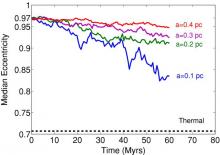
Abstract
Regular star formation is thought to be inhibited close to the massive black hole (MBH) in the Galactic center. Nevertheless, tens of young main sequence B stars have been observed in an isotropic distribution close to it. Various models have been suggested for the formation of the B-stars closest to the MBH (<0.05 pc; the S-stars), typically involving the migration of these stars from their original birthplace to their currently observed position. Here we explore the orbital phase space distribution of the B-stars throughout the central pc expected from the various suggested models for the origin of the B-stars. We find that most of these models have difficulties in explaining, by themselves, both the population of the S-stars (<0.05 pc), and the population of the young B-stars further away (up to 0.5 pc). Most models grossly over-predict the number of B-stars up to 0.5 pc, given the observed number of S-stars. Such models include the intermediate-mass black hole assisted cluster inspiral scenario, Kozai-like perturbations by two disks, spiral density waves migration in a gaseous disk, and some of the eccentric disk instability models. We focus on one of the other models, the massive perturber induced binary disruption, which is consistent with both the S-stars and the extended population of B-stars further away. For this model we use analytical arguments and N-body simulations to provide further observational predictions. These could be compared with future observations to further support this model, constrain it or refute it. These predictions include the radial distribution of the young B-stars, their eccentricity distribution and its dependence on distance from the MBH (higher eccentricities at larger distances from the MBH), as well as less specific expectations regarding their mass function.